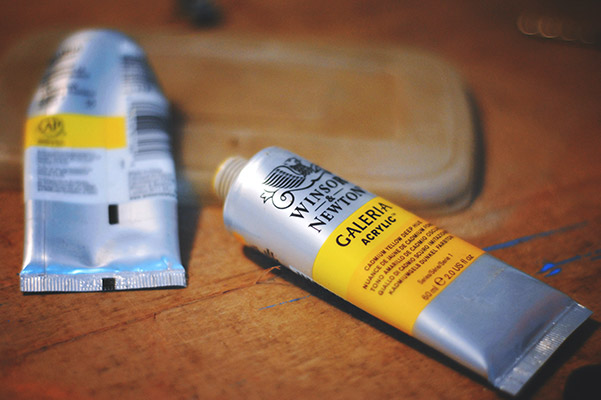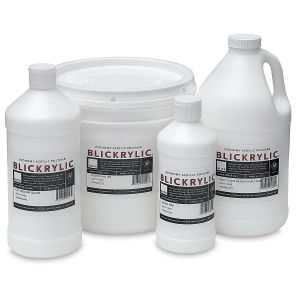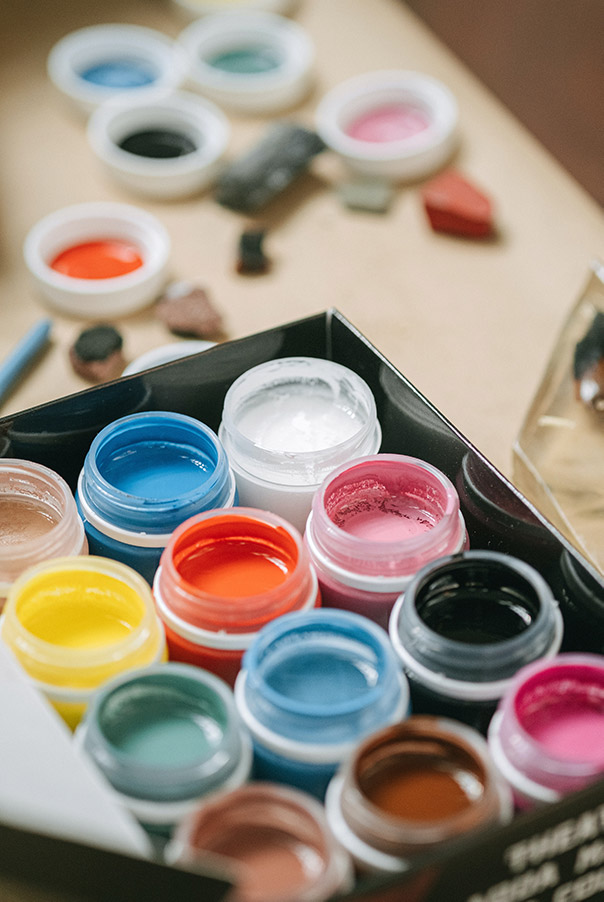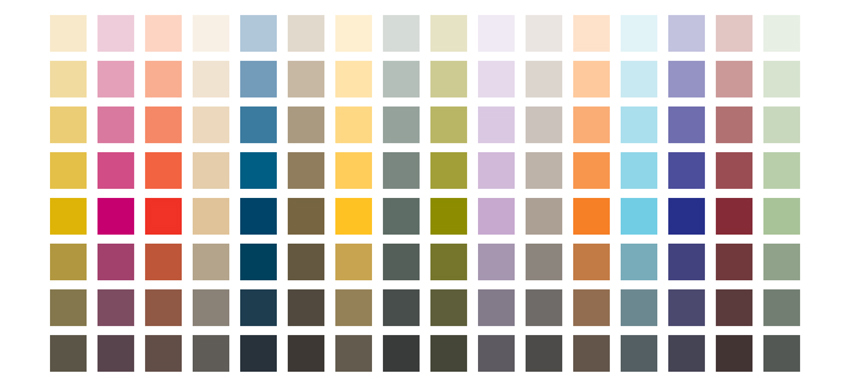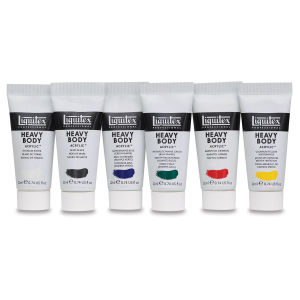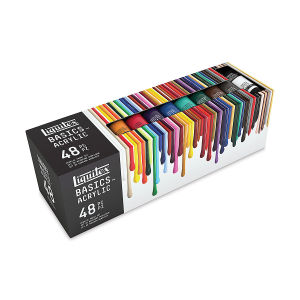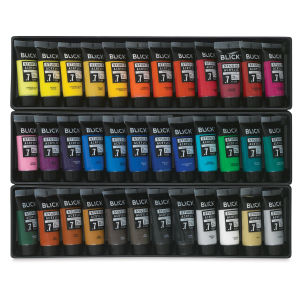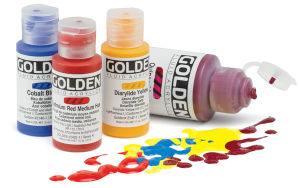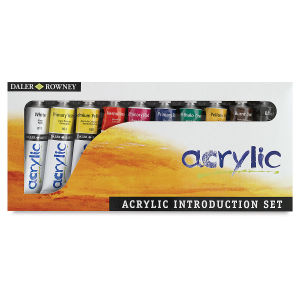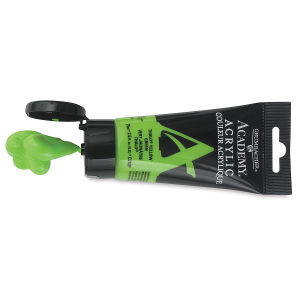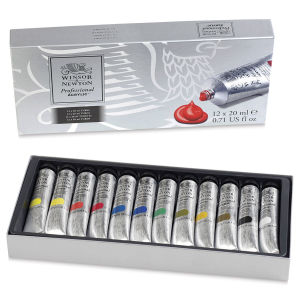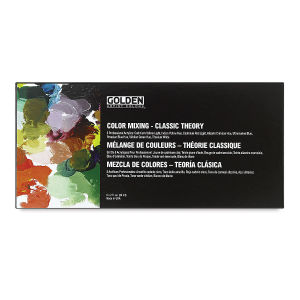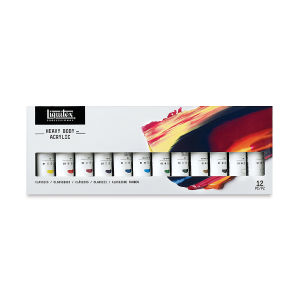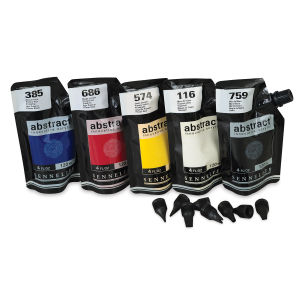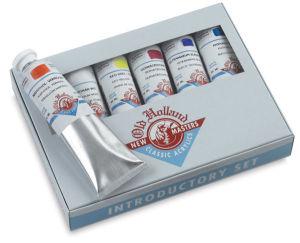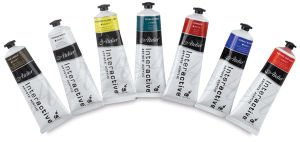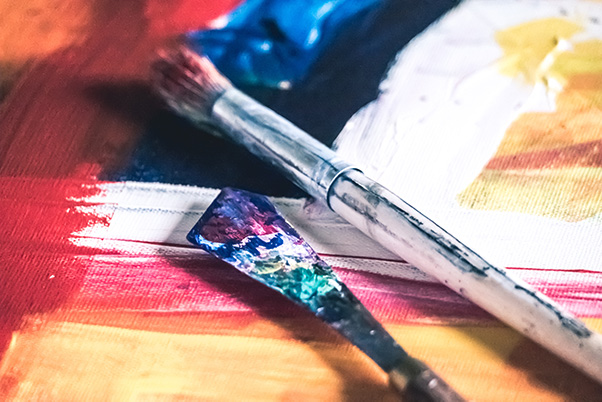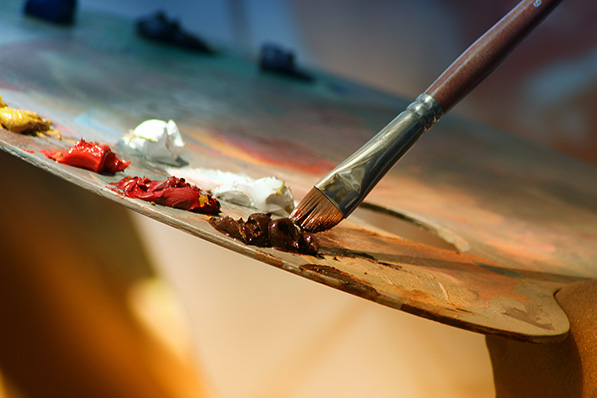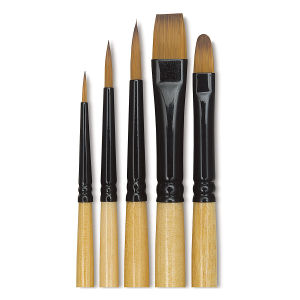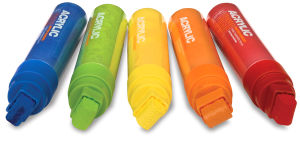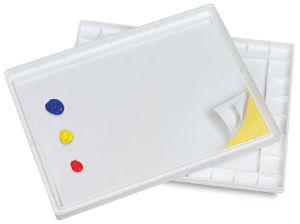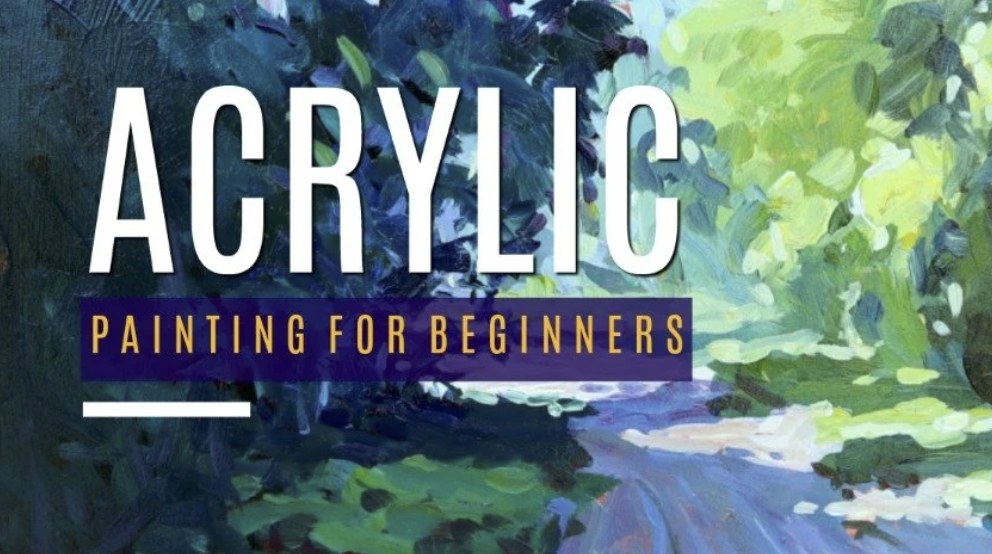- Introduction to the Best Acrylic Paint
- Best Acrylic Paint: Our Choice for Beginners
- Best Acrylic Paint: Our Choice for Professionals
- What is Acrylic Paint?
- Factors to consider when buying acrylic paint
- QUALITY
- CONSISTENCY
- PERMANENCE
- DRYING TIMES
- VIBRANCY
- COLOUR SELECTION
- BRANDS
- Acrylic Painting for Beginners: The 6 best student acrylic paints
- Acrylic Painting for Professionals: The 6 best artist acrylic paints
- Frequently Asked Questions
- Final Thoughts
Introduction to the Best Acrylic Paint
No matter if you are a hobbyist or a professional artist, it is good to know what kind of paints best suit your needs. Yet when it comes to choosing the best acrylic paint, the large variety of products available can pose a challenge. There are dozens of brands to pick from, but with complicated labels including wordings such as “high flow”, “pigment load”, and “open acrylics”, how do you decide what to opt for? What products will lead to the best acrylic painting you desire? To elucidate the selection process, we tested a number of acrylic paint sets that will suit your artist level and needs, and we further explain the most crucial terms to be familiar with.
Best Acrylic Paint: Our Choice for Beginners
- Popular
Liquitex Basics Acrylic - Winsor & Newton Galeria
- Blick Studio Acrylic
- Popular
Golden Fluid Acrylic - Daler-Rowney Graduate
- Grumba-cher Academy
Buy NowBuy NowBuy NowBuy NowBuy NowBuy Now
| Qualities | Popular Liquitex Basics Acrylic |
Winsor & Newton Galeria | Blick Studio Acrylic | Popular Golden Fluid Acrylic |
Daler-Rowney Graduate | Grumba-cher Academy |
| Qualities | $ | $ | $ | $$ | $$ | $ |
| Pigment Load | medium | medium | high | medium | medium | medium |
| Consistency | buttery | smooth | buttery | fluid | smooth | smooth |
| Overall Satisfaction | very good | good | good | very good | good | good |
Best Acrylic Paint: Our Choice for Professionals
- Winsor & Newton Prof.
- Popular
Golden Heavy Body Artist - Liquitex Prof. Heavy Body
- Sennelier Abstract Acrylic
- Old Holland New Masters
- Popular
Chroma Atelier Inter- active
Buy NowBuy NowBuy NowBuy NowBuy NowBuy Now
| Qualities | Winsor & Newton Prof. | Popular Golden Heavy Body Artist |
Liquitex Prof. Heavy Body | Sennelier Abstract Acrylic | Old Holland New Masters | Popular Chroma Atelier Inter- active |
| Qualities | $$ | $$ | $$ | $ | $$$ | $$ |
| Pigment Load | high | very high | high | high | high | high |
| Consistency | smooth | very buttery | buttery | smooth | buttery | smooth |
| Overall Satisfaction | very good | excellent | very good | very good | very good | excellent |
Contents
What is Acrylic Paint?
Acrylic paint is a fast-drying paint consisting of pigment suspended in an acrylic polymer emulsion. A polymer emulsion is necessary since the pigments would float and clump together once water is added. The suspension further helps to disperse the pigments and makes the paint more consistent.
While the majority of acrylic paints are water-based, they become water-resistant once they have fully dried. Depending on how much the paint is modified with mediums, acrylic gels, pastes, or diluted with water, the result can resemble a watercolour, gouache, or oil painting, or it can feature its very unique characteristics, unlike any other media. Good acrylic paint includes various additives which make conservation in tubes and jars possible as we can purchase them in stores. Common additives are preservatives to improve durability, surfactants and initiators which influence the process of drying, as well as thickeners and stabilizers to control the flow qualities.
Acrylic compounds were first synthesized in the mid 19th century. But it was German chemist Otto Röhm who made the practical potential of the new materials public. In 1915, he secured a German patent for polyacrylic ester as a binder for drying oils in industrial lacquers. At this time, acrylic resins were primarily intended for industrial use.
Water-based acrylics became widely available in the 1950s and were sold as latex house paints. Soon artists and companies alike discovered the potential of the new medium, and the first acrylic emulsion artist paints were developed, with modern high-viscosity paints becoming available in the early 1960s. Many well-known artists of the time experimented with the new medium, including Jackson PollockAmerican painter Jackson Pollock (1912 – 1955) was one of the leading figures of Abstract Expressionism and the New York School. He is best known for his large action drip paintings, which he produced between 1947 and 1952, created by pouring and manipulating liquid paint atop canvases set on the floor. Pollock was born in Cody, Wyoming and grew up More, Mark Rothko, Barrett Newman, and Roy LichtensteinRoy Lichtenstein (1923-1997) was a prominent American pop artist who transformed the landscape of modern art with his distinctive comic strip-based paintings. Best known for his bold, graphic style and precise compositions, Lichtenstein's work heavily influenced the Pop Art movement, making profound statements on art and culture through parody and popular media. Born in New York City, Lichtenstein developed an More.
Factors to consider when buying acrylic paint
When trying to find the best acrylic paint brand for your needs, there are numerous factors to be considered. Product labels can be confusing, from quality descriptions to viscosity and consistency – How do you know, which terms are relevant for your choice? Here is a quick rundown on what you need to consider.
QUALITY
The best acrylic paints are available in two different grades: artists’ grade and students’ grade.
Artists’ quality paints are also referred to as professional-grade quality paints.
PROFESSIONAL ACRYLIC PAINT
High-quality acrylic paint, known as artist-quality acrylic paint, contains superior pigments in a high concentration. The amount of binder is limited, which provides for strong and vivid colours, boasting the best permanence ratings. Highly pigmented acrylic paint comes in a large variety of colours, shades, and hues. Drying times, consistency, and viscosity can differ between the colours of different brands, which makes working with the best professional acrylic paint more challenging.
STUDENT GRADE ACRYLIC PAINT
Student grade acrylic paint has a lower pigment saturation, which implies that less pigment is used when combined in the acrylic polymer emulsion. Instead, fillers are used which makes even the best cheap acrylic paint appear chalkier. Therefore, student grade acrylic paints are less expensive than the high concentration artists’ grade paints. Student quality paints are only available in smaller selections. Comparing the two grades, you can see that artists’ colour will have a much smoother consistency and the end results will be much more vibrant. Notwithstanding, student paints are ideal for practising and experimenting. As a beginner on a budget, it makes sense to start with the cheaper students’ quality paint. We recommend upgrading to the good acrylic paint brands of professional quality once you are sure you love acrylics. You will see that investing in a top-notch acrylic paint set makes a difference.
CONSISTENCY
The best acrylic paints come in many different consistencies, also referred to as “viscosity”. Therefore, consistency is not necessarily a reflection of product quality. Which consistency you choose is much more a question of how you want to apply the paint, what painting technique, what brushes you wish to use, and what surface you are going to apply the paints on. Watch out for the following terms on the tube label when picking your colours, since this will also tell you which are the best acrylic paint brushes and the best canvas for acrylic painting according to your artistic project.
Heavy Body acrylics are formulated to have a thick, buttery smooth consistency, providing for a good surface drag for easy handling. Similar to oil paints, heavy body acrylic paint retains brushstrokes, facilitates blending and mixing methods and has an increased open working time. High-quality heavy body acrylics are ideal for thick and impasto applications and techniques since it retains crisp marks that remain flexible after the paint has dried. This means that even thick films will remain free of cracks and chips over time. If you plan to apply traditional techniques emulating oil paintings or if you want to get experimental with mixed media, collages, or printmaking, the best heavy body acrylics available are the right choice.
Soft body acrylic paints in comparison are smoother than heavy body acrylics and are better suited for mixing in different mediums. Since they have a runnier consistency, they can much more easily be spread. Soft body acrylic paint is ideal for many different art projects, including all kinds of decorative arts, traditional painting, murals, printmaking, and fabric painting. More liquid variants are the best paint for acrylic pouring. You can use them on a variety of surfaces such as on canvas, wood, fabric, ceramics, and even porous surfaces.
Fluid acrylics, also called acrylic ink, are even thinner while containing the same pigment concentration so that they produce vibrant compositions. After drying, the finish will have a smooth gloss. Ink products are most versatile, since they cannot only be used traditionally with good acrylic brushes but also with an airbrush or in a pen. They are best suited for projects that require detail work, watercolour techniques, staining, or dry-brush work.
If your artistic projects require a viscosity somewhere in between heavy body, soft body, or fluid, you can use many different acrylic mediums such as gel medium for acrylic paint, texture gels, modelling paste, glazing medium, and matte/gloss medium. Blend these acrylic mediums into the paint to achieve the particular consistency you need. Accordingly, you can thin or thicken the paint, add some texture, alter drying times, or achieve an extra matte or gloss finish.
PERMANENCE
Permanence, or “lightfastness”, refers to how the acrylic paint reacts when exposed to light. The ability of a pigment to resist gradual fading is measured against a time period of 20 years of gallery exposure. Products with pigments that tend to fade quickly over time are called “fugitive colours”. However, the large majority of acrylic colours has much better permanence ratings than other materials such as watercolours or oil paint, which is a great advantage.
Look out for lightfastness standards on the label of the paint product when buying acrylics. ASTM International, formerly known as the American Society for Testing and Materials, classifies acrylic colours according to the following standards:
ATSM I = Excellent Lightfastness
ATSM II = Very Good Lightfastness
ATSM III = Not Sufficiently Lightfast
You will either find the ATSM standards on the tube or jar label or the following manufacturer classifications:
**** or AA = Extremely permanent colours
*** or A = Durable colours.
** or B = Moderately durable colours.
* or C = Fugitive Colours
We recommend always opting for excellent or very good lightfastness unless you just want to experiment and practice. Fugitive colours are also suitable for children’s craft projects.
DRYING TIMES
How long does acrylic paint take to dry? Generally, acrylic paints dry quickly which means that you have to work fast if you want to make changes to the first brush stroke. Most artists appreciate the fast-drying quality since this is good for layering or projects such as painting on top of acrylic pour.
Although the average drying time is 20-30 minutes, there are a few factors that can have an impact on the drying time of acrylic paints such as what brand and what quality of paint you are using, and how wet the paint is. Other factors which influence the drying time of acrylic paint include room temperature, humidity, and air circulation. Cool, damp areas will slow down the drying time, while painting in a dry, warm room, windy conditions, and low outdoor humidity will speed up the process. Furthermore, there are brands of fast-drying acrylic paints that can be purchased, such as the product Galeria by Winsor & Newton, which take approximately 10 minutes to touch dry. These properties are considered the best craft paint for wood and glass by many hobbyists.
Some techniques will require wet paint, for example when applying wet-into-wet, emulating the usage of oil paints. High-quality acrylic paint known as “formulated open paints” possess these slow-drying properties and are very similar to the application of oil paints.
So-called “interactive paints” dry just as fast as ordinary acrylic paints, however, you can apply a liquid “unlocking formula”. With this formula you are able to wet the already dried interactive paint again, allowing for further alterations to your brush strokes. In order to finally lock the paint, a medium fixer will be necessary.
VIBRANCY
Colour vibrancy is largely dependent on the pigment source, the purity of the pigments, and the concentration of pigments within the tube of acrylic paint. You will find that some pigments are not naturally sourced but synthetically produced, usually those which end in “hue”. Most professional or artist quality acrylic paint, in contrast to student grade paint, will generally have a higher concentration of natural pigment, ultimately leading to brighter end results. Therefore, it is worth it to invest in a good brand of acrylic paint.
COLOUR SELECTION
Countless colour options are available for acrylic painting. If you aren’t an experienced artist, this abundance can be overwhelming. Which colours should you buy when first starting to paint with acrylics? We all know that it is possible to mix a rainbow of shades and hues using just the three primary colours red, green, and yellow. Yet many artists prefer the ease of applying the desired colour directly from the tube. Furthermore, particular ready-made colours have simply a higher intensity than anything you would be able to mix yourself. Especially as a beginner, it is good to know how to limit your colour palette while still being able to come up with the colours you want to use in your painting. We recommend getting a tube of each of the following colours for a start:
- titanium white
- mars black
- cadmium red medium
- phthalo blue
- cadmium yellow medium
- burnt umber
- phthalo green
- dioxazine purple
- cadmium orange
Alternatively start with an acrylic paint set, which will not only save you money per tube but will also solve the problem of picking the colours yourself. Using the best beginner acrylic paint set recommended below will help you not to stress too much about the materials in the beginning and to just pick up the brush and get going.
Among the best acrylic paint for artists, you will find out that some colours are much more expensive. While earth colours are usually the least expensive, other colours that derive from cadmium can cost three times as much. The reason is that some natural pigments such as cadmium are hard to attain. When buying colours, look out for series numbers with 7 being the most expensive and 1 having the lowest prices. As mentioned above, some companies offer cheaper colours in which pigments are substituted synthetically, at the expense of permanence and colour intensity.
BRANDS
What is the best brand of acrylic paint? With the wide range of acrylic paints available on the market, it is hard to decide which brand to pick. Many experts recommend buying several products of different brands and performing your own experiments to eventually decide on your own favourite. However, we are aware that trial and error can be both time-consuming and expensive. After all, you want to focus more on the process of painting than on experimentation.
What are the best acrylic paint brands? While some brands are definitely better than others, when it comes to the top companies it is really only a matter of individual preferences. The products we recommend in this post are all offered by high-quality brands so that you cannot go wrong. While buying jars will give you more paint for your money, starting off with a smaller, less expensive tube will provide the possibility of testing the brand first. As we will explain, the best acrylic paint brand for beginners will not necessarily be the best acrylic paint for professionals. Once you have particular brands that you are happy with you can still buy a few jars. We have used all the following brands with great satisfaction:
In the following, we will look at individual products to help you find the best acrylic paint for your needs. Our review is split up into two sections, starting with student grade acrylics before recommending a number of professional quality paints including the best acrylic paint set. Please keep in mind that a “pro” of a brand might be a “con” for you, or vice versa, depending on individual styles of painting and skill levels. The order in which the brands are presented does not indicate any kind of rating system.
Acrylic Painting for Beginners: The 6 best student acrylic paints
Liquitex Basics Acrylic Paint Set
This set of 48 tubes (each 22ml) is ideal for artists who are just starting to explore the world of acrylics. Even if the pigments are not as intense as in professional-grade paints, the large range of colours of this high-quality acrylic paint set will still make your artwork shine. The texture of these good acrylic paint set colours is buttery, but thinner than the heavy body artists’ paints, making them ideal for layering up your artwork. In case you need more texture in your painting, simply mix in an impasto gel of your preference. Liquitex Basics Acrylic Colours dry to a satin finish while eliminating surface glare. Once fully dried up, the paints are permanent, flexible, and water-resistant.
While these colours are among the best acrylic paints for canvas on the beginner level, you can use them for a variety of further projects, including watercolour, airbrush, printmaking, and mixed media techniques. The paints are very versatile when combined with Liquitex Basics Acrylic Mediums.
One big advantage is that Liquitex sells these paints not only as a set but also individually so that you can stock up easily once you have run out of your favourite paints.
Pros:
- Available as set and individually
- Good price
- Wide range of colours for a student set
- Good lightfastness
- Versatile
- Dry to a satin finish without surface glare
Cons:
- Tubes are a bit small for larger projects
- Colours not as intense as artists’ grade version
Buy Liquitex Basics Acrylic now
Winsor & Newton Galeria Flow Acrylics
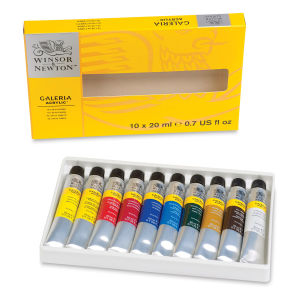
Acrylic painting for beginners can start with this set of 10 colours (each 20 ml), which deliver professional results at an affordable price. The paints are ideal for students and hobbyists, decorative painters, and fine artists alike due to their versatility in usage. Their consistency is smooth, similar to oil paint for quick and easy coverage and strong brushstroke retention. The free-flowing consistency makes them easy to blend for beginners.
These colours also count among the best acrylic paint for canvas; however, they are also suitable for other surfaces such as canvas, paper, leather, fabric, wood, and brick. Once the colours are fully dry, they are water- and weather-resistant, which makes them a good choice for murals and other outdoor projects. Although considered as student grade, the high pigment levels of Winsor & Newton Galeria Flow Acrylics deliver outstanding results.
Pros:
- Good quality for reasonable price
- Weather resistant
- Versatile
- Straight from the tube workability
- Vibrant colours
- Open time is longer than average acrylic paint which is good for blending
Cons:
- Can only be shipped inside USA
- Colour selection of set is not ideal
Buy Winsor & Newton Galeria Flow Acrylics Now
Blick Studio Acrylic Paints
The student-grade Blick Studio Acrylics set of 36 colours (each tube 21 ml) offers great value for beginners. The wide range of hues are highly pigmented compared to other non-professional grade paints, providing for good coverage and colour intensity. The buttery, oil-like texture perfectly holds impasto brush marks after drying. Blick Studio Acrylics dry to a non-yellowing paint film that has proven good lightfastness and flexibility without cracking. You can dilute your colours with Gloss Medium for washes on sealed surfaces and with water for washes on absorbent surfaces such as paper.
Pros:
- Brilliant colour pigments
- Good for mixing colour
- Good variety for understanding colour theory
- Easy to clean from brushes
- Smooth and easy to spread
- Can be purchased individually
Cons:
- Full colour range not always available
Buy Blick Studio Acrylic Paints Now
Golden Fluid Acrylic Paint
Golden Fluid Acrylic Paints provide great colour brilliance due to lightfast pigments. With a consistency similar to heavy cream, they are more liquid than the paints reviewed above, not containing any fillers or extenders. Due to the fluid texture, they are ideal for spraying, staining, and brushing. They are furthermore widely considered to be among the best acrylic paints for pouring art projects. Unlike heavy-body paints, Golden Fluid Acrylic offers fine dispersion and high tinting strength as well as durability and flexibility.
If you want to create heavier brush strokes, you can blend Fluid Acrylics with Golden Gel Medium to thicken the paint as desired. Thanks to the thin consistency, it is very easy to incorporate Gel Mediums into the pigment.
Pros:
- Paints retain excellent flexibility after drying
- Easy to mix with gel medium
- Versatile due to liquid quality
- Good adhesion on non-oily surfaces
Cons:
- Without medium, does not hold brushstrokes when drying
Buy Golden Fluid Acrylic Paint Now
Daler-Rowney Graduate Acrylic Paints
Daler-Rowney Graduate Acrylics offer an affordable range of water-based colours. The paints are ideal for students and hobbyists looking for good performance and reliability. With a smooth application, they are easy to use and to mix with different colours of the same quality. Due to their fast-drying quality, Daler-Rowney Graduate Acrylics are good for layering and for covering large surfaces. Once dried, the paints are durable, they stay flexible and the strong colours assure that the paintings last a long time. The paints can withstand rough treatment and won’t crack even if the canvas or the paper support is rolled.
Since Daler-Rowney Graduate Acrylics do not contain any solvents, they are even suitable for children to use. A unique valve mechanism on the squeezable tubes minimizes waste and special stay-clean technology minimizes mess.
Pros:
- Non-toxic
- No cracking after drying
- High pigment load
Cons:
- Texture feels like plastic after drying
Buy Daler-Rowney Graduate Acrylic Paints Now
Grumbacher Academy Acrylics
Grumbacher Academy Acrylics is a line of 48 process colours as well as metallic and iridescent colours at a very affordable student price. Due to good-quality pigments in high concentration, all colours have an ASTM lightfast rating of 1 and superior tinting strength. The paints come in 90 ml metal tubes as well as in 75 ml and 200 ml plastic tubes. However, there are only two small sets available, a colour mixing set of 5 colours for learning colour theory, and an introductory set of 6 colours.
Unlike other budget brands, Grumbacher uses genuine pigments such as pure cadmium for Academy Acrylics and the hues including the best metallic acrylic paint are carefully formulated. They underlie the same quality standards as Grumbacher’s professional paints, which means that colours of different series can easily be mixed together.
Since the drying times are very fast, the products should not be considered the best acrylic paints for beginners but are more suitable for the intermediate-level painter. The paint’s texture is quite thin so that it needs an additional thickening medium if an impasto technique is to be applied.
Pros:
- Applies well to support
- No colour shift after drying
- Very affordable
- High quality pigments
Cons:
- Not suitable for impasto techniques
- Dries too quickly for beginner level
Buy Grumbacher Academy Acrylics Now
Acrylic Painting for Professionals: The 6 best artist acrylic paints
Winsor & Newton Professional Acrylics
As a high-quality brand, Winsor & Newton Professional Acrylics offer advanced painters clean and brilliant colours in a creamy texture. They rank among the best acrylic paint for professional artists. 80 different colours are available including a wide range of tones and hues, both in tubes of 60 ml, 200 ml, and jars of 237 ml. Even the earth tones, whites, and blacks appear clean and never dull. Their transparent binder eliminates the colour shift from wet to dry, letting you make the most of spontaneous painting techniques. This way colours can be matched more easily from the palette to the canvas, immediately seeing what the painting will look like when dried. For best results, use Winsor & Newton Professional Acrylics in combination with a professional artist paint brush set.
Pros:
- High pigment load
- Easy to mix
- Convenient packaging
- Wide assortment of colours
Cons:
- Slow drying times
Buy Winsor & Newton Professional Acrylics Now
Golden Heavy Body Artist Acrylic
Sold both individually and as a set, Golden Heavy Body Artist Acrylics are the perfect choice for experienced artists who want an extra bit of body in their medium. The texture of the paints is exceptionally smooth and buttery so that they retain the form of brushstrokes or palette marks on the canvas. Artists who prefer the thicker texture will be pleased with an extra sparkle on their finished products. Due to the thick consistency, you will need a separate palette knife for mixing. Using a brush for mixing will lead to unclear colour and there will further be the risk of damaging your best acrylic paint brush.
The Golden Heavy Body contains a large assortment of pure pigments in an acrylic emulsion without added fillers, extenders, or dyes. Depending on the nature of each pigment, the colours are formulated differently: Colours that can tolerate higher pigment loads will dry to a more matte finish, while more reactive colours that do not accept high pigment loads will dry to a glossy, more transparent finish. Heavy Body Acrylics are free from additives leading to a different gloss for each colour. If a homogenous finish is needed, we recommend using some of the best varnishes for acrylic painting after your canvas has fully dried.
Pros:
- Wide array of colours
- 90 standard colours and extra assortment of grays, iridescent, and fluorescent colours
- Intense pigment saturation
Cons:
- The fluorescent pigments are not lightfast (all other colours have excellent lightfast ratings)
- For some purposes, the texture might be too buttery
Buy Golden Heavy Body Artist Acrylics Now
Liquitex Professional Heavy Body Acrylics
The colours of the Acrylic Studio Set of the Series Liquitex Professional Heavy Body Acrylics have a buttery smooth consistency with a good surface drag and ideal blending characteristics. The set consists of 12 essential colours for beginners and advanced artists alike. Due to their extra high pigment load, they produce rich and brilliant colours. The paints are ideal for traditional techniques on canvas, as well as experimental, collage, mixed-media, and printmaking applications.
We liked the colours when using them for impasto applications since they retained crisp brush strokes and palette knife marks that remained flexible even after drying. Thick films stayed free from cracks and chips over time.
Pros:
- Wide assortment of colours
- Reasonably priced
- Long shelf life
- Easy to be removed from hands and clothing
Cons:
- More filler than other professional grade acrylic paints
- Only medium coverage
- Slow drying time
- Bad odour
Buy Liquitex Professional Heavy Body Acrylics Now
Sennelier Abstract Acrylic Paints
The Sennelier Abstract Acrylic Paints line offers highly pigmented, heavy body acrylics. They come in a unique and economical pouch instead of in tubes or jars. The plastic of these squeezable pouches is transparent so that it is easy to see exactly which colour you are going to get for your painting. Furthermore, the pouches are easy to handle: Besides traditional usages with paint brushes for acrylic painting or acrylic palette knives, you can apply the paint directly to the canvas from the package, which is ideal for heavy impasto work. For this kind of application, you can further attach eight different assorted paint tips to create a variety of painting effects, including double lines, thin or heavy lines, or wavy shapes. From our view, the less heavy body version of the product, the Sennelier Abstract Acrylic Paints, are among the best acrylic paints for pouring techniques.
Pros:
- Convenient and innovative packaging
- Good price range for large amount of paint
- High pigment load
- True colours
Cons:
- Paints in the pouches dry quickly if no retarder added
Buy Sennelier Abstract Acrylic Paints Now
Old Holland New Masters Classic Acrylic Paints
As the world’s first producer of oil paint, the Old Holland brand carefully formulated synthetically formed paints to emulate the characteristics of their world-famous oil colours. The result was 170 opaque and transparent colours, some of the best acrylic paints for artists, whose texture is very close to the quality of oil paints. A large number of pigments were tested with unique acrylic binder mediums different from the common binders. This binding system, which incorporates a high pigment concentration, was patented, providing professional artists with superior quality paints.
While the paints are more costly, the pure acrylic binder sourced from a boutique European manufacturer imparts a unique characteristic to these paints, ensuring outstanding colour retention, adhesion on a large variety of materials, and other working properties. The colours dry to a satin gloss, making them ideal for both high-build impasto and ultra-thin glazing. Make sure you use some of the best acrylic brushes for professionals to fully enjoy these high-quality paints.
Pros:
- Great colour intensity
- High pigment load
- Buttery texture
- Good workability
Cons:
- Higher price
- Product dries quickly in tube
- Only individual paints available, not sets
Buy Old Holland New Masters Classic Acrylic Paints Now
Chroma Atelier Interactive Acrylics
Chroma Atelier Interactive Acrylics are the best choice for artists who are experienced in watercolour painting and are switching to acrylics. Formulated using patented technology, the Interactive Acrylics offer a versatile set of working properties that are unlike those of any other brand’s products. While in application, they perform like conventional acrylics, allowing for traditional canvas painting and glazing techniques, you get more control over the drying process, since the colours can be reactivated. By spraying the paint with water or a special type of medium, you can go back in and re-work certain sections of the painting as desired. This way you do not have to choose between paints with slow or fast drying times.
However, the technique for re-working is not easy so that the paints are only suitable for experienced artists. It is important to equip yourself with the best brush for blending acrylic paint and to use only the best paper for acrylic paint or high-quality canvas since reworking and rewetting will put strain on your tools and the surface.
Pros:
- Good range of compatible mediums
- Can be unlocked
- Flexible drying time
- Good alternative both to oil and watercolours
Cons:
- Higher price range
- Steep learning curve
- Poor packaging
Buy Chroma Atelier Interactive Acrylics Now
Frequently Asked Questions
How do student grade and artist grade paints differ?
As outlined above, artist-grade paints usually have a better acrylic polymer emulsion as a basis, higher pigment concentrations, outstanding archival qualities, and produce more vibrant results. Student paints are the right choice if you just start experimenting with acrylics, if you see it as a hobby, or for children’s projects. If you paint professionally or create commercial pieces, you should definitely opt for artist grade paint.
Should I buy individual colours or a set of acrylic paints?
When you are just starting off, we recommend choosing a set of colours. With so many paint colours available, it is hard to decide which colours to buy in the beginning. The overwhelming feeling that descends when trying to buy acrylics either online or in your local store can simply be overcome by opting for the pre-boxed starter set and getting going. Once you know which colours you love, you can choose to buy larger jars of the paints needed.
What is the best acrylic paint for beginners?
According to our tests, the Liquitex Basics Acrylic Paint Set is the best choice for beginners. They are appropriately priced, offer a wide range of colours, good lightfastness, and are very versatile. Read our review above to find out more.
What is the best acrylic paint for professionals?
We had the best experience with the Golden Heavy Body Acrylic Paint Series due to their intense pigment saturation and beautiful buttery texture. The thicker paint is a great choice for impasto and many other techniques. Read the full review above to find out more. If you prefer a more liquid texture, Golden sells also Fluid Acrylic paint featuring a more liquid formula.
Can you mix acrylic paints of different brands?
We recommend using just one brand of acrylic paints in a project since the colours might dry with different finishes in the end. If you still wish to mix several brands, bear in mind to do so only with paints of similar thickness, the same additives, and the same grade (student grade or professional grade) – otherwise mixing results will be impacted. Furthermore, water-based paint should never be mixed with oil-based paints.
What surfaces can you use acrylic paint on?
One big advantage of acrylic paints is their versatility – Acrylics can be painted on just about any support, as long as it is dust and oil-free, including canvas, paper and cardboard, wood and composite panels, patterned fabric, silk, metal glass, terracotta pots and all kinds of objects. A common question regarding acrylic painting is if you need to use a gesso primer. Technically, you do not need gesso. However, it provides you with a slightly more absorbent surface to work on, especially if you are working on board or raw canvas.
What is the best art paint for wood?
The best art paint for wood is acrylic colour. To guarantee the longevity of brilliant colours, make sure to use some of the best primers for acrylic paint on wood. Choose a primer that has been specifically designed for wood and plays well with acrylics. The best acrylic paint for wood will have a high pigment load and a smooth texture, if you want to enjoy your work for many years, make sure to use artist grade paint. After you are done with your crafting project on wood, make sure to properly seal your project with a sealer specified for wood. Sealers are also known as varnish and they provide a protective coating over your paint. According to your preferences, either choose a glossy or matte finish.
Are acrylic paints waterproof?
Once acrylic paint is fully dried it becomes water-resistant. However, it will not be fully waterproof. In order to better protect your work, you need to prepare the painting surface before beginning to paint and apply a sealer after completion.
Are acrylic paints non-toxic? Can I use them as body paint?
Most acrylic paints are considered non-toxic. Still, some colours can contain heavy metals, which will be indicated on the product label. Even though non-toxic, it is not recommended to use acrylic paints directly on the skin, since they could cause irritation. Use some special body paints that are intended for use on the skin instead, or make your own edible finger paint, which is great for toddlers and kids of all ages!
Do I need special brushes to paint with acrylics?
Yes, you should use brushes specifically designed for acrylic painting. The best brush for acrylic paint will hold the pigments very well, making the finish look smooth and even. It will have synthetic fibres that are super durable with an excellent spring to it. The brass ferrule should be of great quality holding the bristles well together and making the brush comfortable to use. You can wash the best paint brushes for acrylic painting repeatedly without any signs of wear and tear.
Are acrylic paint pens a good alternative?
If you enjoy painting but the cleaning up afterwards dampens your enthusiasm or you struggle with mixing the paint to the right consistency, acrylic paint pens can be an alternative. They are a no-brush painting tool where the paint comes encased in a pen with a tip as the paint outlet. This way, you can get a painting look through a process that is more like drawing. Unlike watercolour or ink pens, this pen tip oozes actual acrylic paint. The best acrylic paint pens will allow you to work with great precision on metal, wood, plastic, fabric, etc. and will dry rapidly. They are not suitable if you plan to do a lot of colour blending or large scale paintings.
Do I need special paper to paint on with acrylics?
If you are a beginner, we recommend starting either with wood or canvas as a surface for painting, since you can achieve greater brightness and vividness of colours on these surfaces. If you want to use acrylics on paper though, the best paper for acrylic painting will be heavyweight and specially designed for the use of acrylics, providing enough tooth for acrylic paint. Alternatively, you can use heavyweight watercolour paper as well. If you would like to experiment with different surface textures, you can try rough grain, cold press, or hot press variants. The rough grain paper will have a bumpy surface, the cold press will be a bit less bumpy, while the hot press paper is the smoothest.
Is a palette necessary when painting with acrylics?
Unless you dip or splatter your paint directly from the tube onto the canvas, you will need a palette to temporarily store and mix your paint. Acrylic palettes come in many different materials and shapes, for example, made from glass, plexiglass, plastic, palette paper, or wood. Which will be the best palette for acrylic paint depends on your personal preferences. Since acrylic paints dry out very fast, a good choice is “stay-wet” palettes, which are designed to retain moisture.
How fast does acrylic paint dry?
Most acrylic brands will take around 20 to 30 minutes to dry, such as Golden (excluding Golden’s Open Acrylics), Liquitex, Sennelier, Winsor & Newton. Some of the Heavy Body Acrylics have much slower drying times. For example, Golden Open Acrylic can take up to two days to fully dry. Atelier Interactive is a category in itself, which can be reactivated by spraying with water or an unlocking medium.
Remember though that environmental factors will also influence the drying time of your acrylic paint. In a hot and dry climate, or if there is a breeze, the paint will dry much faster.
Final Thoughts
The definite answer as to which brand of acrylic paint is the best one can only be: “It depends!” After all, the personal taste, the project, and the level of artistry will have a big impact on what paints are preferred. We hope to have given you a good overview of the brands we appreciate ourselves. We feel confident in our decision that we found some of the best student and professional grade artist paints out there.
What is your favourite acrylic brand? We would love to hear from you. Please leave your comments below.
Click here if you are looking for some more gift ideas for artists and creatives, need some sketch inspiration or color combination ideas.
If you would like to level up your painting skills, get art materials tailored to you and make sure to check out these painting classes on Skillshare:
You might also enjoy reading the following posts by Pigment Pool:
25 Facts to Know About Egon Schiele: Klimt, Women, and Austrian Expressionism
A Brief History of Colour Pigments
The Art of Hanging Art: How to Follow and Break Rules
The Best Watercolor Paint Set for Artists and Hobbyists In 2022
Art Travel – An Eye-Opening Trend with History
Ultimate Guide to the Best Colored Pencils – Must-Know Facts for Hobbyists and Artists
The Best Drawing Pens for Artists and Hobbyists in 2022
This article may contain compensated links. Please read Disclaimer for more info. As an Amazon Associate, I earn from qualifying purchases.

